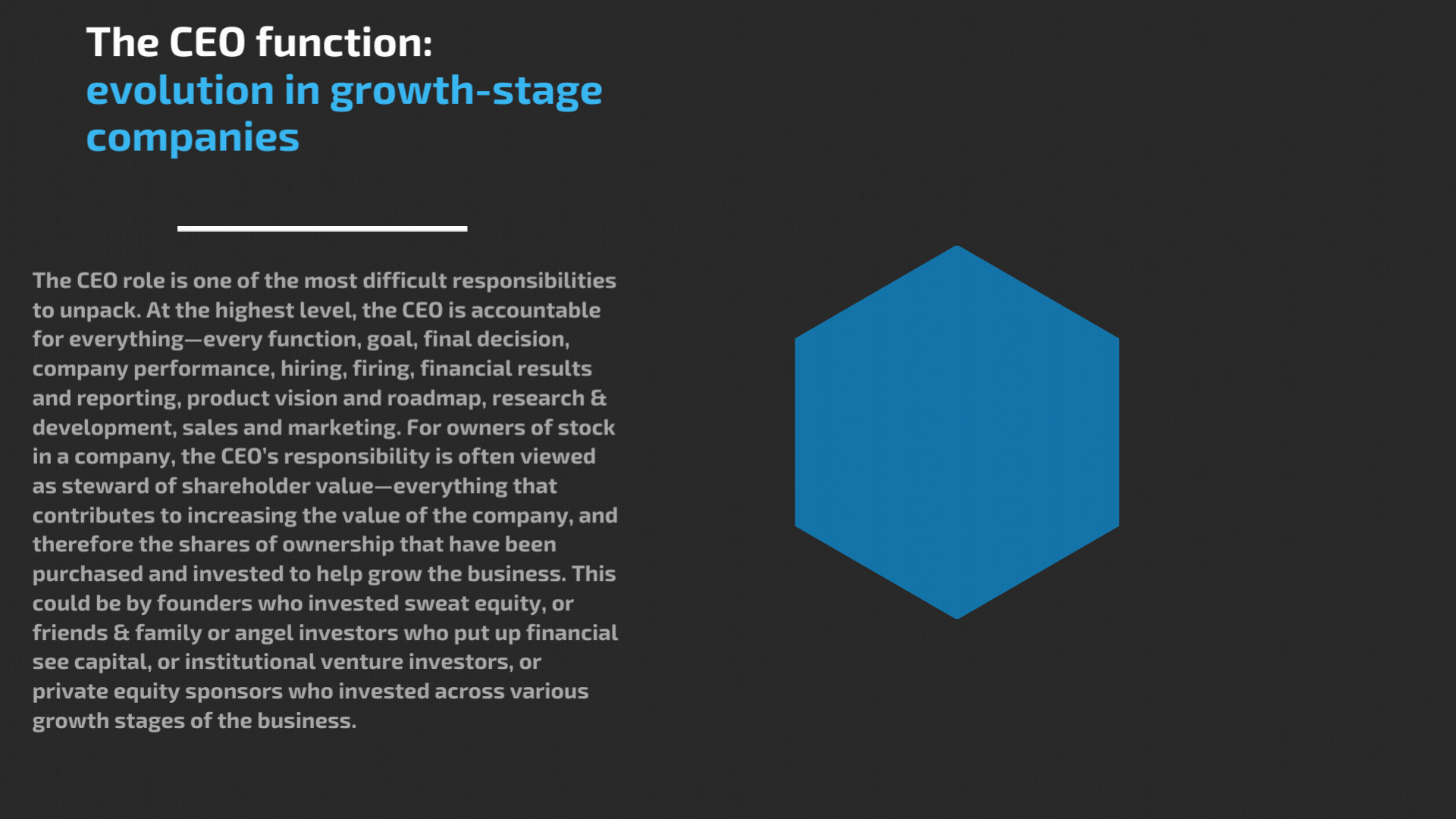The Evolution of the Executive Function
EXECUTIVE & THE CEO [CHIEF EXECUTIVE OFFICER]

What are the organizational implications as a company grows?
The CEO role is one of the most difficult responsibilities to unpack. At the highest level, the CEO is accountable for everything—every function, goal, final decision, company performance, hiring, firing, financial results and reporting, product vision and roadmap, research & development, sales and marketing. For owners of stock in a company, the CEO’s responsibility is often viewed as steward of shareholder value—everything that contributes to increasing the value of the company, and therefore the shares of ownership that have been purchased and invested to help grow the business. This could be by founders who invested sweat equity, or friends & family or angel investors who put up financial see capital, or institutional venture investors, or private equity sponsors who invested across various growth stages of the business.
At the earliest stages of a company’s growth & evolution, the CEO may be the actual do-er, manager & leader, functioning in all levels of company development. However, as a company evolves, it can be helpful to parse the CEO’s role into for what they are accountable, versus for what they are responsible. Using these two terms, accountability is a skip-level, indirect ownership for making sure things get done and goals are achieved. The CEO as “manager” but not actual “do-er” of those functions and their related deliverables, so an indirect ownership of them, executed by others in their organization for which the CEO has ultimate accountability but those others have direct responsibility. If we define the term “responsible” for our purposes as direct versus indirect ownership of outcomes, it can help clarify the CEO direct responsibilities at a more granular level.
Let’s divide these CEO responsibilities by dividing them into what we can call “hard” and “soft” categories.
On the “soft” side, the CEO is responsible for the following company roles & goals:
-
Organizational development & leadership
- Defining the organizational structure of the company at the senior most levels and then the subsequent management & leadership of the executive team
-
Company vision
- Creating the long-term destination the company will target (“Colonization of Mars” for SpaceX)
-
Company culture
- The “how” things get done inside the organization. What is rewarded, and what is punished. Culture is the codification of company values, akin to the legislative & judicial system’s role in relation to the executive branch of government.
-
Company mission
- The "what we do" needed to achieve the vision and medium-term "BHAG" (“big, hairy, audacious goal” as popularized by researcher & author Jim Collins in his book “Good to Great”)
-
Company values
- The belief system, guiding principles around which company employees coalesce in the pursuit of a common goal.
-
Company goals
- Sometimes confused with the “mission” or “vision” (see above), a clarifying example was President Kennedy’s stated goal of putting a man on the moon before the end of that decade. Goals are usually time-defined, versus vision that is most often not.
One could think about the primary responsibility of the CEO being the leader who defines for the company the “Who,” the “What” and the “How”—
- The “Who” is very much set by the CEO, and is closely tied to the company mission. “Who we are” and the role the company plays in their specific ecosystem to add value and worth to the world.
- The “What” is the responsibility for determining what the company’s products and/or service offerings are gong to be
- The “How” can be divided into two subcategories
- The strategies employed by the company to achieve the vision and goals they’ve set for. So this is often quite literal—how to build and deliver these products & services. Will the company build, buy, or partner to achieve this? Will the company take an innovator/pioneer approach and be first to market (think Apple Computer in the case of the iPhone), or a fast-follower approach (in the case of Samsung’s mobile phone offerings)
- But the “How” can also be closely tied to the culture & values the CEO sets for the company. What are the acceptable behaviors allowed in achieving company goals, and what behaviors are not Think back to Siemens in the early 21st century when they were accused and convicted of widespread corruption in their selling practices, using bribery to win large contracts. Or Enron, etc.
The CEO is very much the principal “compass setter,” evaluating and deciding which direction the company should take, why that direction, and what are the acceptable boundaries or ground rules for the mission.
What remains for the CEO as a direct report? It depends on the business sector. However, typically, the CEO retains direct functional reporting responsibility of
- Finance
- Strategy
- Research & Development
- Corporate development (when inorganic growth is part of a company’s growth strategy, and focuses on the targeting and negotiations of mergers & acquisitions often focused on geographic or product/service-offering gap-filling and/or expansion)
- Board of directors reporting responsibility and direct interface. To be clear, the CEO reports to the board
Depending upon the industry sector, human resources is considered a strategic vs. support function and also may report to the CEO, but again often with a solid line to the CEO, but heavy dotted line to the COO for the day-to-day, week-to-week blocking and tackling for which HR is responsible.

